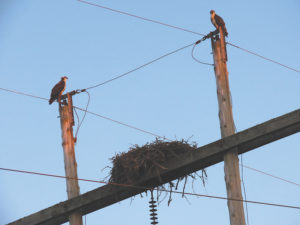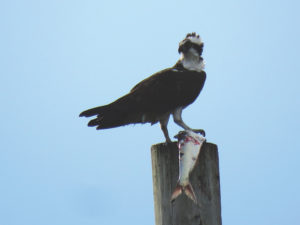Come April, ospreys — the large raptors also known as sea hawks — make their thousands-of-miles-long journeys from South America back to Cape Cod to nest. A peek inside their unique homes, which can be seen sitting at the tops of utility poles, chimneys, and docks, reveals that the birds’ returns are accompanied by annual home improvements.
Ospreys
NATURAL SELECTION
Outer Cape Outage Revives Osprey Debate
Audubon and Eversource disagree on how to keep nests off power lines
Over 100 years ago, in an agrarian Massachusetts, farmers began training ospreys to nest — not in trees, but on man-made platforms.
The intent was to use the birds of prey on farms to ward off red-tailed hawks, which fed on chickens.
The training was successful, and Cape Cod is dealing with the consequences to this day.

On Thursday, Aug. 13, about 10,000 people from Wellfleet to Provincetown lost power in their homes because of an osprey nest on a power line on Gross Hill Road in Wellfleet. Eversource took down the nest in the process of restoring power.
Osprey nests interfering with power lines are a common occurrence on the Cape, according to Mark Faherty, science coordinator at Mass Audubon’s Wellfleet Bay Wildlife Sanctuary.
“Either the birds themselves or sticks from the nest can interfere with the wires and cause a fire, or cause outages,” he said.
The recent outage has rekindled strife between wildlife organizations such as Mass Audubon and the state’s largest energy company, Eversource, over how to handle osprey nests on power lines.
Under the Migratory Bird Treaty Act of 1918, it is illegal for utility companies to remove nests with eggs in them, or with recently hatched chicks that cannot fly. In the case of the Gross Hill Road nest, the chicks had fledged, meaning they had already learned to fly.
That doesn’t mean the birds aren’t still using the nest, however.
“There is this vague period after [ospreys] fledge when they can fly but they haven’t learned how to fish,” said Emily Achtenberg, who has been a volunteer osprey monitor at the Wellfleet sanctuary for 10 years.
“They use the nest, and the parents bring back the fish,” she said. “That’s where they all eat.”
Achtenberg has observed the Gross Hill Road nest for Mass Audubon since before Eversource took it down. She said the family is still flying around the area where the nest was.
Faherty doesn’t see a problem with Eversource taking the nest down at Gross Hill Road, calling it a “no-brainer,” considering that it cut power for 10,000 people.
His issue is with Eversource’s commitment to providing the birds with a safe alternative to nesting on power lines.
Members of Mass Audubon, Wild Care, and Cape Wildlife have met several times with Eversource to discuss a more neutral way to deal with the osprey population, according to Faherty. The wildlife community, he said, wants Eversource to pay for the construction of nest platforms, like the one at Wellfleet Harbor.
Building the platforms is easier said than done, according to Eversource spokesperson Reid Lamberty.
“Every time we try to build an osprey platform, we not only need the permission of the town, but sometimes the property owner, if it is on private property,” he said. “The home owners have told us no.”
Instead, Eversource’s primary strategy for dealing with nests is to install “deterrents” on poles to keep the birds from building. The most common deterrent is a corrugated half-pipe designed to make the nest slip off when the birds try to build.

Every fall, when the ospreys migrate from the northeast, Eversource removes the empty nests and installs the deterrents in their place.
The problem is that deterrents don’t work, according to Faherty.
When ospreys migrate back to the Cape in the spring, they look for their old nest to reuse, he said. Ospreys are often so stubborn about using the same nest that they will rebuild a new one in the same place right on top of the slippery pipe.
“[Eversource] rips the nest down, puts up some deterrents, and hopes the birds will nest in the trees,” Faherty said. “They won’t — they nest on the next pole down. We don’t feel that they have a good system to deal with nests on local power lines.”
Nests built on the deterrents are also more likely to shed loose sticks onto the lines and cause fires or outages, meaning that the strategy creates more problems than it solves, he added.
Lamberty acknowledged the issue, saying, “When we install a deterrent, sometimes they will go back there still and try to build.” But he added that there is no clear alternative.
“We will work to help out as much as we can,” he said. “We do try, because the ospreys are very important.”
Finding a safe alternative for the birds is not something the company can do for every case of a nest on a power line, Lamberty said.
Faherty believes Eversource needs to take more responsibility for the nests.
“They are not Audubon’s birds, they are not God’s birds — they are your birds,” he said.
